Because the columns on my clock were very crooked (and broken at the tops) as well as the fact that 2 main components had large cracks through them (the right side and the base), the decision to completely knock the case apart was made early on.
This restoration started in late summer 2014 and was only completed yesterday when I finished working on the crown and attached it to the case. I was not working on the clock continually, but I was to reinforce the fact that this was a 2 year project. Despite all the work, however, I find that these are some of the most rewarding restorations to work on. These cases are exceptionally beautiful, and one can't help but admire all the work and skill that went into making them.
See "before" photos here: http://jcclocks.blogspot.ca/2016/01/john-birge-co-1848-column-cornice-clock.html
Main Case Work:
Case knocked apart:



This chip was not very visible in the "before" photos, but it was simple to repair.


Something that is quite odd is that the shadow and glue line where the columns were attached seem to show a decent amount of age. The crooked columns had been that was for quite a while, though I'm confident that they would never have left the factory that way.

A lot of the new and old glue (from previous repairs) had to be painstakingly removed from case components.

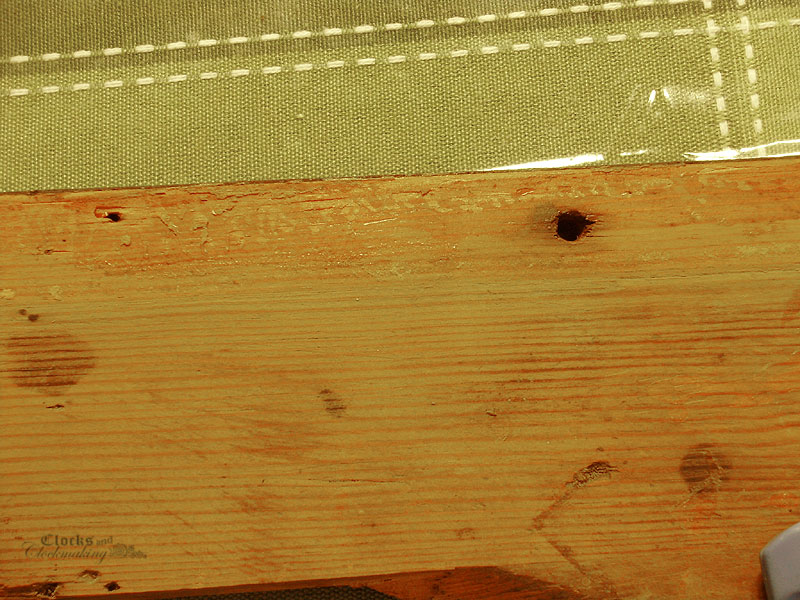
For several months working on this on and off, this is generally what the work area would look like. Piles of veneer, case pieces, tape, pencils, saws, and chisels everywhere. Note: 3 different clock cases were being worked on, as well as a mahogany veneered box, and 2 violins, which are visible in several other photos.

This shows the chip above being patched (temporarily taped in place), as well as the base for a Seth Thomas wooden works (one of the sides is visible just above it).

I'm holding the John Birge top (above) as well as the top of the Seth Thomas wooden works (below).

These were the remains of the veneer chips from one side of the John Birge base. They were not worth saving with the clock, but the veneer was kept for other small repairs.

It's always useful to have a wide variety of veneer on hand. These are packets of matching crotch mahogany veneer that were purchased in bulk very inexpensively on eBay. I have a lot of pieces to choose from, which is very helpful when patching figured mahogany veneers.

The top of the case had an odd break in it which was caused by a flaw in the board. The break had also shrunk slightly and curved under the driving weight. It was lined-up and glued as close as possible to the original alignment.

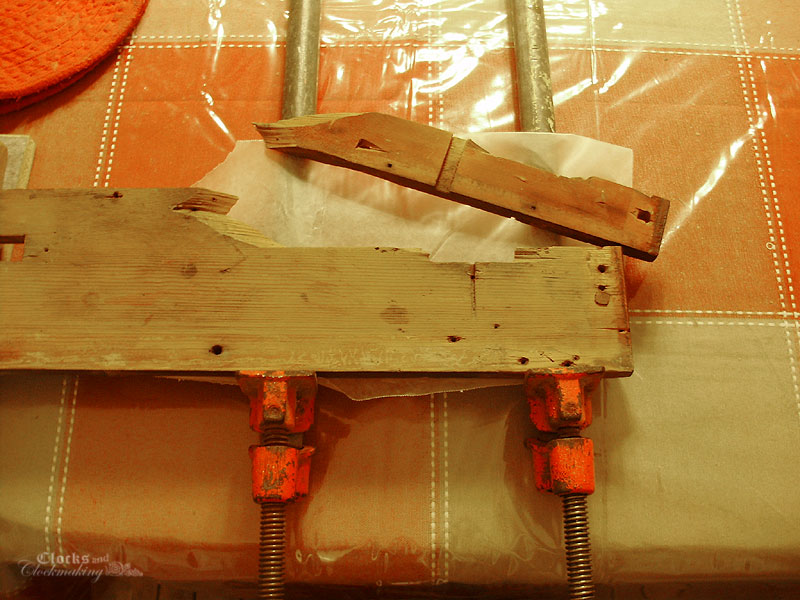
The most important part in this particular case, is that the outside edge lines up evenly.

Partially repaired top (right), partially repaired Seth Thomas top (centre) and the base of the John Birge showing a large diagonal crack that will need to be fixed (left).

More bits and pieces. This shows the door of the "mystery" wooden works clock, which I was also working on.

Here you can see the break to the base. This is what caused some of the veneer to break off on the side as well as on the front of the base. The arrow shows a broken and worn back corner, which was later patched with wood.
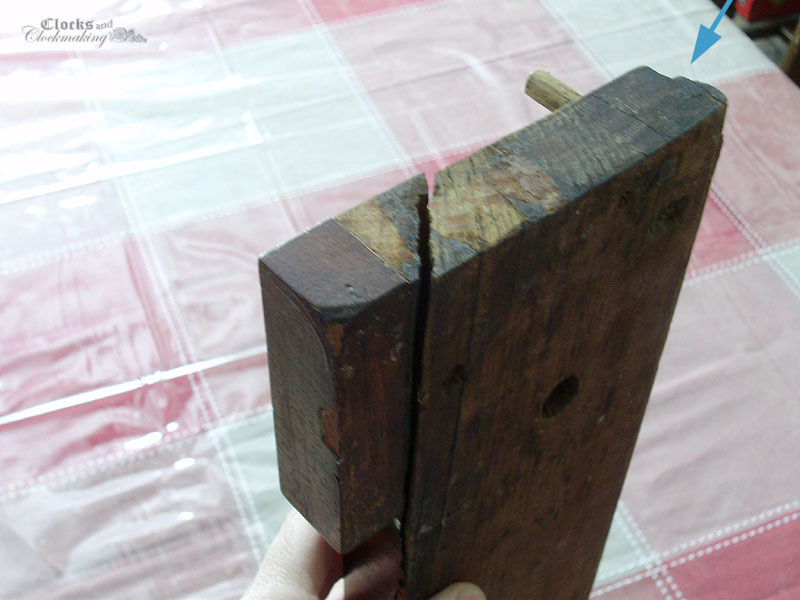


Veneer breaks on both doors.

One loose corner joint, and another chipped corner.

This was after gluing the crack in the base.

More veneer scraps and chunks of solid wood for repairs. A tiny instrument maker's saw is always good to have for veneer work. I also use those two tiny wooden squares fairly often.

Repairing the crack on the right side.

Gluing thick wood veneers on both ends of the base.

Starting to re-assemble the case.


These next photos show how the broken corners of the column capitals were repaired. The breaks were cut into clean shapes with flat surfaces. New pieces of mahogany were cut and fitted, then glued in place.
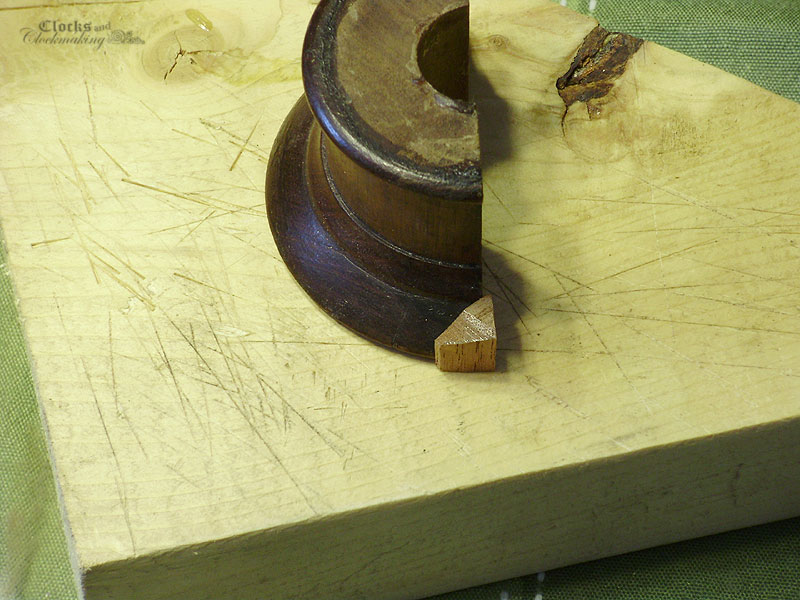
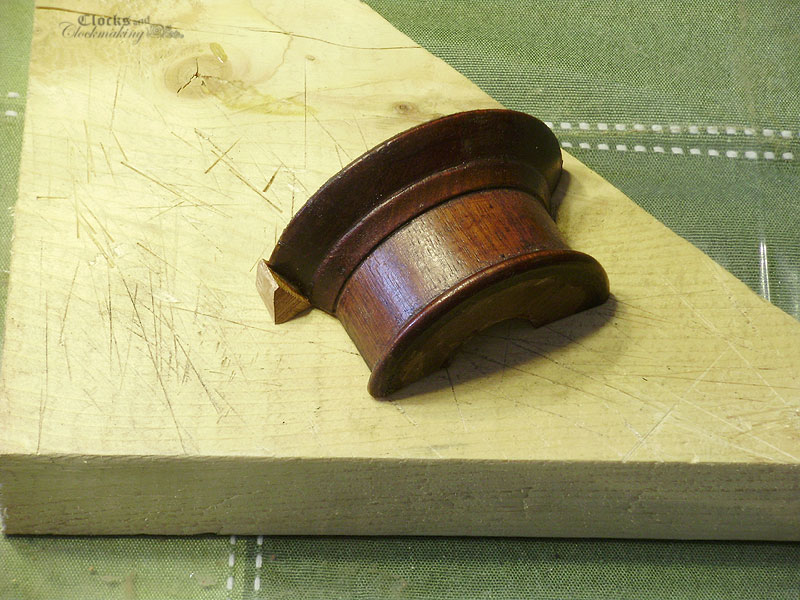
Since the wood is oriented in a way that makes it very fragile, the bulk was trimmed slowly and carefully with a small saw, and the rest was very carefully cut with sharp chisels. Once the shape was correct, the profiles were sanded smooth.

Stain.

Additional shading, toner, and shellac:

Gluing and nailing the columns in place. Square nails were used.

Interior views. Note that the vertical strip (stop moulding) for the lower door, is new. It was glued in place and antiqued to match.

Also note the two badly damaged/worn corners were repaired.

These are mostly included to show the case construction. I had to make sure that the vertical strips were installed correctly for the door to clear properly. Even the tiniest difference in the spacing will mess this up, so make sure to temporarily install the door when gluing and nailing these vertical members (before columns are attached).


If any of the label needs repairs, do this before reattaching the back.
Bits & Pieces:
I was able to purchase a set of correct "Spade and Pointer" hands for the clock, however, the minute hand had about 1/4" clipped off, which I repaired later. You will also note that I was able to remove that large black stain between the 9 and 10. I believe I used paint thinner to remove it, but I'm not 100% sure.

New hooks were prepared (and antiqued) for the clock. Gun Blue was used for this.
Before:

After:

The Crown:
The crown gets its own separate section because about half the case restoration work was on this one item. This particular crown was in worse shape than most, because it had some previous (poor) repairs. Some of these repairs included sanding down the top edges of the crown making them uneven and unsightly. Because of this, new long thin wedges had to be glued in place, and then blended in. The left side of the crown was also a later replacement without any mahogany veneer on it. The shape wasn't perfect, but it was very close.
To be able to glue veneer to this, it would need to have all the finish and stain sanded off.


New crotch mahogany veneer (oriented in the "short grain" direction) was prepared, boiled in water to soften it, then clamped in place to pre-shape it.

After drying, it was then glued to the base wood with hide glue. While the glue dried (slowly), a few small cracks formed in the veneer, but nothing too serious. Another thing to note: these John Birge clocks have the thin top strips of veneer along the crown in the "long" direction, while later Birge clocks have the veneer in the "short" direction. Match what's on your case, as this can make a big difference.


This detail photo shows some of the botch repair by a previous restorer, where the glue lines in the crown didn't add up, so the crown was sanded down crooked. Since the veneer here was also chipped, I replaced the entire section.
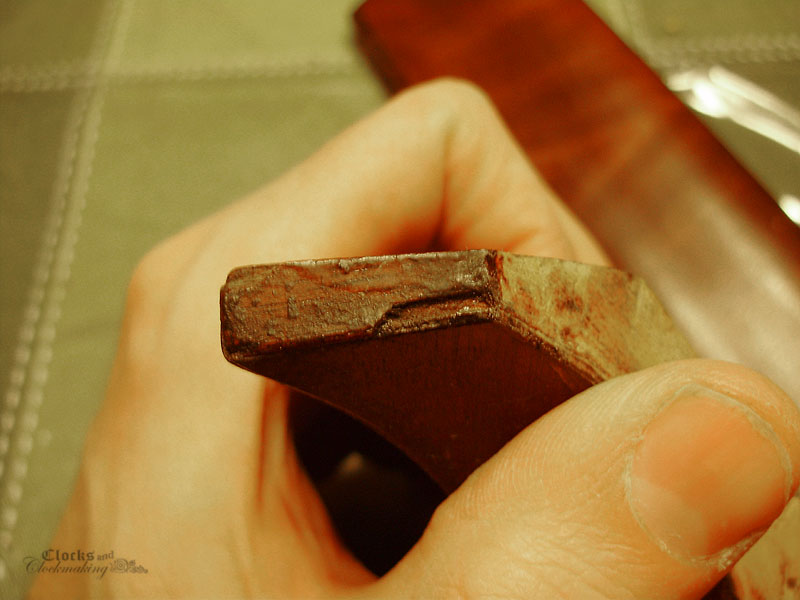
Some of the wood was removed to fit a new patch.

The same was done on the opposite side, but the veneer on this one was good, so I carefully cut around it.



These are all the chunks and wedges ready to glue in place.

The crown was re-assembled using a paper template guide, as well as "spring clamps" made from old upholstery springs.
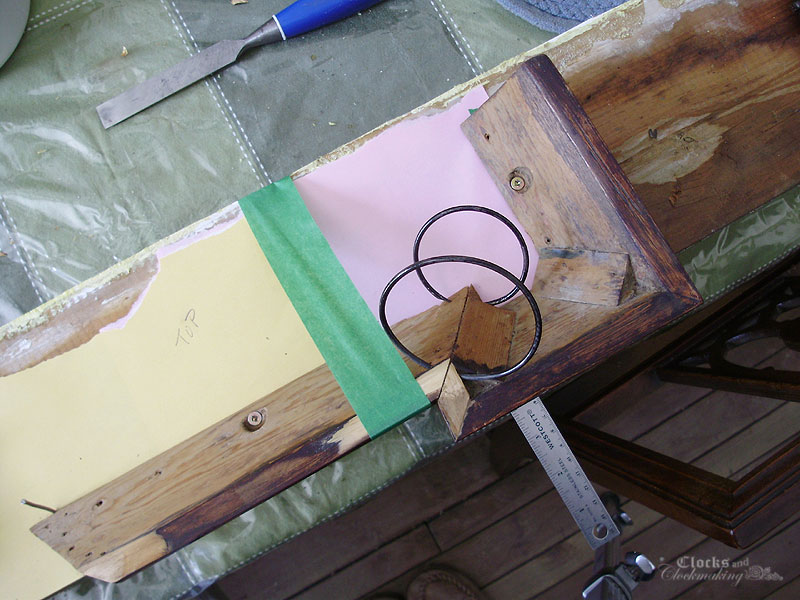

After staining and finishing the re-veneered section, it continued to develop cracks, and it was NOT looking good at all.


I decided to remove all the veneer and start over. The moulding was sanded to bare wood again, and this time I used contact cement instead of hide glue. I didn't want to use contact cement, but I knew it would work, and the base is not original, so I didn't feel too bad about it. I will have to practice veneering with hide glue for future projects.
The newly repaired and finished section of crown was then glued to the rest of the assembly.


New glue blocks were made and installed to replace the missing ones on the left side.

These two are original.

A new mounting hole was drilled (carefully - to line up with the old existing hole). A spade bit was used for this, as well as a 3/16" bit to open-up the centre.

Here's the re-veneered section.

Detail of some of the patches.


After all those repairs, the crown was then glued, screwed, and clamped to the case.

The last part was to blend and antique the finish on the top to hide all the repairs. I was pretty happy with the results.
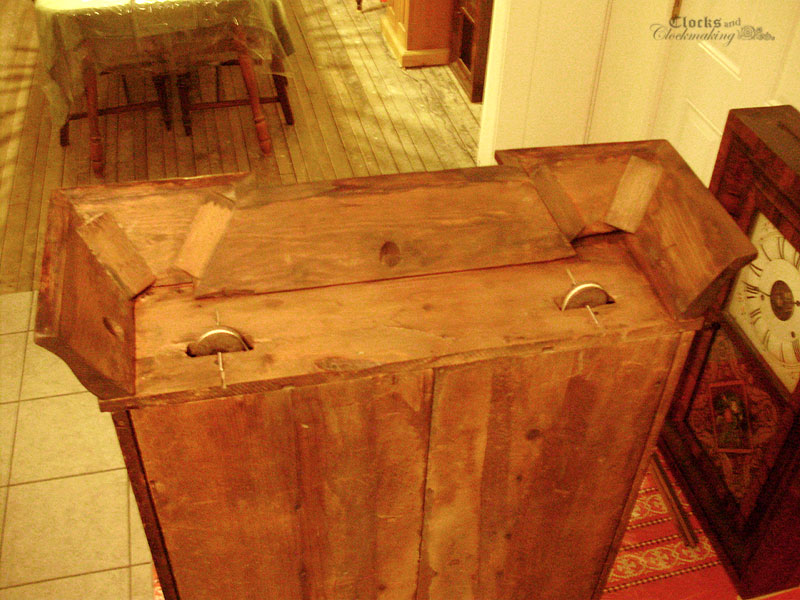

No comments:
Post a Comment